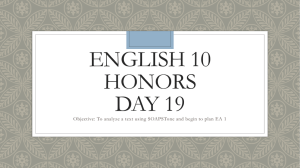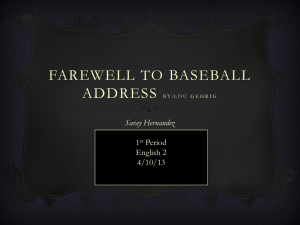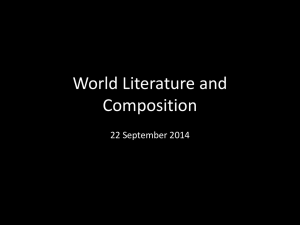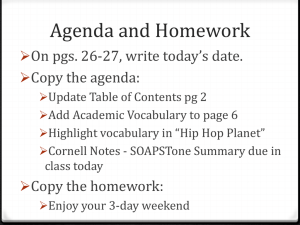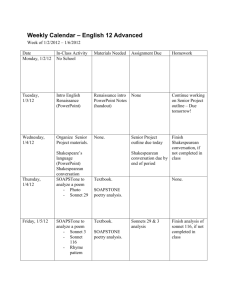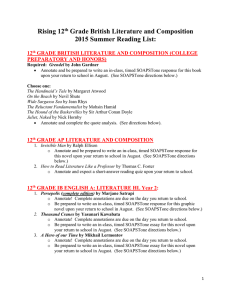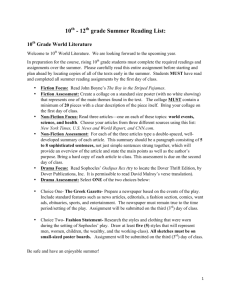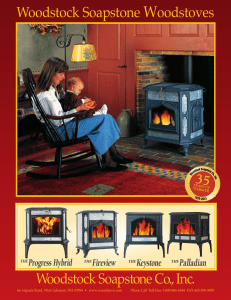AP English Language and Composition
advertisement
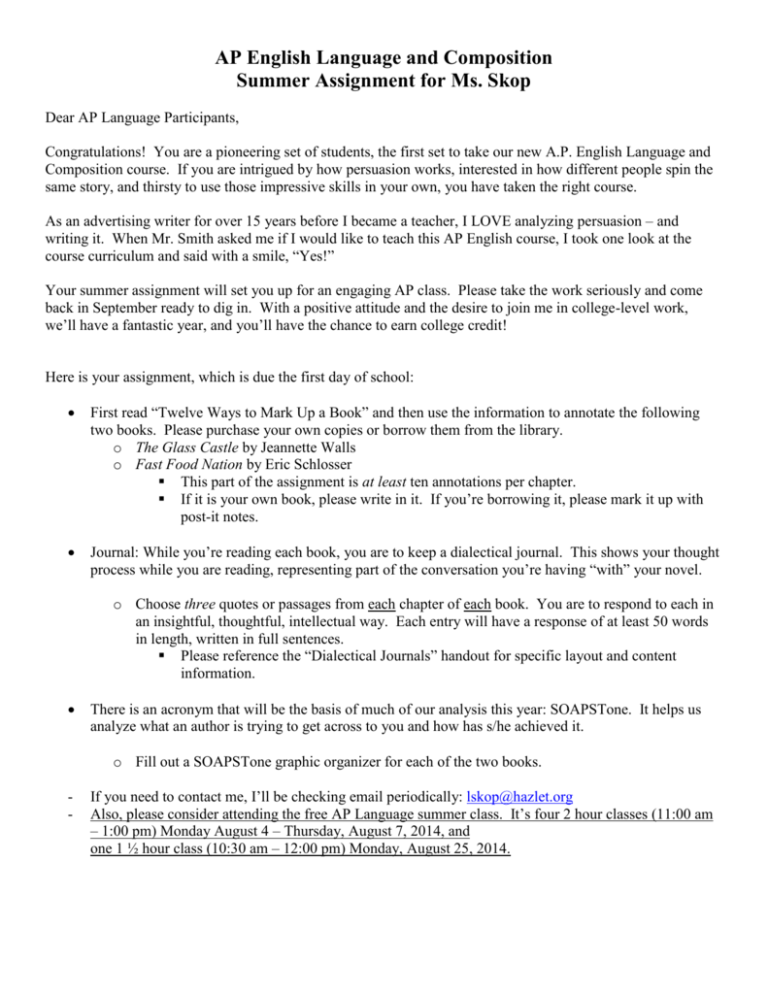
AP English Language and Composition Summer Assignment for Ms. Skop Dear AP Language Participants, Congratulations! You are a pioneering set of students, the first set to take our new A.P. English Language and Composition course. If you are intrigued by how persuasion works, interested in how different people spin the same story, and thirsty to use those impressive skills in your own, you have taken the right course. As an advertising writer for over 15 years before I became a teacher, I LOVE analyzing persuasion – and writing it. When Mr. Smith asked me if I would like to teach this AP English course, I took one look at the course curriculum and said with a smile, “Yes!” Your summer assignment will set you up for an engaging AP class. Please take the work seriously and come back in September ready to dig in. With a positive attitude and the desire to join me in college-level work, we’ll have a fantastic year, and you’ll have the chance to earn college credit! Here is your assignment, which is due the first day of school: First read “Twelve Ways to Mark Up a Book” and then use the information to annotate the following two books. Please purchase your own copies or borrow them from the library. o The Glass Castle by Jeannette Walls o Fast Food Nation by Eric Schlosser This part of the assignment is at least ten annotations per chapter. If it is your own book, please write in it. If you’re borrowing it, please mark it up with post-it notes. Journal: While you’re reading each book, you are to keep a dialectical journal. This shows your thought process while you are reading, representing part of the conversation you’re having “with” your novel. o Choose three quotes or passages from each chapter of each book. You are to respond to each in an insightful, thoughtful, intellectual way. Each entry will have a response of at least 50 words in length, written in full sentences. Please reference the “Dialectical Journals” handout for specific layout and content information. There is an acronym that will be the basis of much of our analysis this year: SOAPSTone. It helps us analyze what an author is trying to get across to you and how has s/he achieved it. o Fill out a SOAPSTone graphic organizer for each of the two books. - If you need to contact me, I’ll be checking email periodically: lskop@hazlet.org Also, please consider attending the free AP Language summer class. It’s four 2 hour classes (11:00 am – 1:00 pm) Monday August 4 – Thursday, August 7, 2014, and one 1 ½ hour class (10:30 am – 12:00 pm) Monday, August 25, 2014. Twelve Ways To Mark Up A Book By Bert Webb Books are a fantastic way to gain knowledge. With books, one can learn new techniques, gain new skills, and learn from role models who have been to where one wants to be and can show the way. There are many different ways to read books and just as many ways to remember their salient points. One of the most effective ways to get the most out of a book is to mark it up. There is no standard way to mark up a text, but below are a few ways that students have found effective in marking up a textbook so that one can see the important points quickly, make it more memorable, and make it easy to pick up years later and re-acquaint oneself with the major concepts. What Not To Do Don’t use a highlighter – Quality marking isn’t done with a fat-tipped highlighter. You can’t write, which is an important part of marking the text, with a large marker. Get yourself some fine point colored pens to do the job. Don’t mark large volumes of text – You want important points to stand out. Although we all know that everything can’t be important, we often highlight all of the text on the page. You want to find the 20% of the text that is important and mark that. Don’t take the time to mark up items that you read on a daily basis – (e.g., magazines, newspapers), unimportant or irrelevant items. Don’t mark the obvious – Don’t waste time marking up things that are already in your knowledge-base or skill set. If you already know it, you don’t need to mark it. What To Do Mark the text with a pencil, pen, or, even better, colored fine-tipped pens – Remember, you are not highlighting, you are writing. Know your preferences – Some of you have an aversion to mark directly in the text. Books are precious things to many people and they want to protect them from damage and even the wear and tear of everyday use. If this describes you, grab some Post-It brand notes and do your marking and writing on them. This also gives you the advantage to move and reorganize them should you see fit. As for me, I like to mark directly on the page. I find that my books become more valuable to me when I add my contributions to the information that they contain. Underline the topic sentence in a passage – Remember, each paragraph has one topic sentence. The rest is supporting information and examples. Identify the topic sentence to find it easier. Use codes – Flag text with codes (e.g., Question marks to indicate disagreement, Exclamation marks to note agreement or to flag a strong statement, triangles to indicate a change in thinking, or a star for the topic sentence). Write the passage topic in the margin as a reminder – Just a word or two. Write questions in the margin – When you don’t understand something or when you don’t understand the author’s thought process on a particular topic, write the question in the margin as a reminder to settle the question. Circle new and unfamiliar words – Look them up as soon as possible. Add your or other author’s perspectives in the margins – Other authors have surely written on the same subject. What do they say? Do they agree with this author? If not, what do they say. Add these ideas in the margins. Add cross-reference notes to other works on the same topic – Use the author’s name and a shortened version of the other book’s title. Add structure to a narrative text – Use 1, 2, 3, 4…or an outline format I. A. B. C. 1, 2, 3, a, b, c…to add a structure that you understand. Draw arrows to related ideas – Or unrelated ideas… Summarize – Add your own summary after the last paragraph. That simple exercise will crystalize your thinking on the topic. If you can’t write it, you don’t understand it. Extras Post-It Brand Notes are great ways to also mark locations within books, much like bookmarks do. With Post-It Brand Notes, however, you can mark on them so you can see where you are turning before you start flipping through the pages. One can also use colored paper clips to identify pages or chapters that are important. Conclusion The idea is to enter, by way of your markings, into a conversation with the author so that his knowledge is added to yours so that a synthesis occurs and you gain a new understanding. A new — or new looking — book is a treasure. In my experience, however, I have found that a well-marked book, becomes more like a treasured friend — one that you enjoy seeing again and again. It becomes much more enjoyable than a sterile copy that comes straight from the bookstore. Don’t be afraid to mark up the books that you love. Webb, Bert. "Open Loops: Twelve Ways To Mark Up A Book." 'Open Loops'. N.p., n.d. Web. 5 June 2014. <http://hwebbjr.typepad.com/openloops/2006/02/twelve_ways _to_.html>. SOAPSTone Graphic Organizer Title of Piece: The Glass Castle Author: Jeannette Walls SOAPStone Components: Subject Occasion Audience (Turn Over) The general topic: Consider the title What is the text mainly about? Summarize key events/details here… Context: The time and place of the piece What is the historical context? What’s the genre? (speech, poem, sermon…) WHO is it for? Who is hearing or reading or seeing the text? Is it one person, a small group, or a large group? What qualities, beliefs, or values might the audience members have in common? Response (Include Text Support) Purpose So WHAT? WHY is the author presenting these ideas? What does he or she want the audience to do, feel, say or choose? Speaker WHO is speaking? Whose voice tells the story? What do we know about the writer’s life and views that shape this text? Tone Emotional Mood or Effect: What emotions describe the attitude of the speaker? Which words or details let you know? Which persuasive techniques or appeals are used to enhance the tone or mood? Examples: angry, threatening, light-hearted, cheerful… SOAPSTone Graphic Organizer Title of Piece: Fast Food Nation Author: Eric Schlosser SOAPStone Components: Subject Occasion Audience (Turn Over) The general topic: Consider the title What is the text mainly about? Summarize key events/details here… Context: The time and place of the piece What is the historical context? What’s the genre? (speech, poem, sermon…) WHO is it for? Who is hearing or reading or seeing the text? Is it one person, a small group, or a large group? What qualities, beliefs, or values might the audience members have in common? Response (Include Text Support) Purpose So WHAT? WHY is the author presenting these ideas? What does he or she want the audience to do, feel, say or choose? Speaker WHO is speaking? Whose voice tells the story? What do we know about the writer’s life and views that shape this text? Tone Emotional Mood or Effect: What emotions describe the attitude of the speaker? Which words or details let you know? Which persuasive techniques or appeals are used to enhance the tone or mood? Examples: angry, threatening, light-hearted, cheerful…
